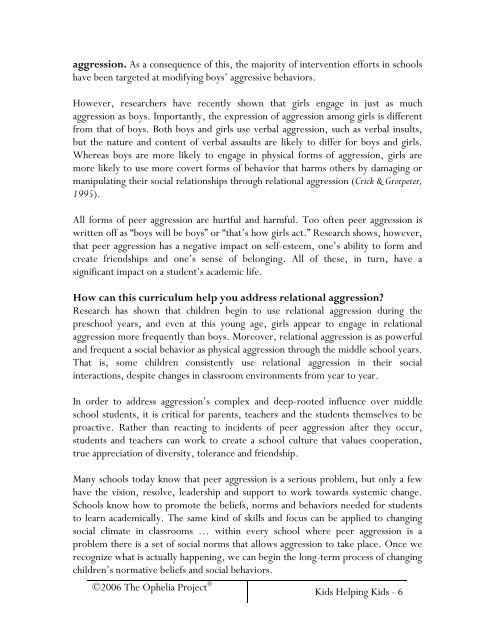Kids Helping Kids
KidsHelpingKids
KidsHelpingKids
- No tags were found...
Create successful ePaper yourself
Turn your PDF publications into a flip-book with our unique Google optimized e-Paper software.
aggression. As a consequence of this, the majority of intervention efforts in schools<br />
have been targeted at modifying boys’ aggressive behaviors.<br />
However, researchers have recently shown that girls engage in just as much<br />
aggression as boys. Importantly, the expression of aggression among girls is different<br />
from that of boys. Both boys and girls use verbal aggression, such as verbal insults,<br />
but the nature and content of verbal assaults are likely to differ for boys and girls.<br />
Whereas boys are more likely to engage in physical forms of aggression, girls are<br />
more likely to use more covert forms of behavior that harms others by damaging or<br />
manipulating their social relationships through relational aggression (Crick & Grotpeter,<br />
1995).<br />
All forms of peer aggression are hurtful and harmful. Too often peer aggression is<br />
written off as “boys will be boys” or “that’s how girls act.” Research shows, however,<br />
that peer aggression has a negative impact on self-esteem, one’s ability to form and<br />
create friendships and one’s sense of belonging. All of these, in turn, have a<br />
significant impact on a student’s academic life.<br />
How can this curriculum help you address relational aggression?<br />
Research has shown that children begin to use relational aggression during the<br />
preschool years, and even at this young age, girls appear to engage in relational<br />
aggression more frequently than boys. Moreover, relational aggression is as powerful<br />
and frequent a social behavior as physical aggression through the middle school years.<br />
That is, some children consistently use relational aggression in their social<br />
interactions, despite changes in classroom environments from year to year.<br />
In order to address aggression’s complex and deep-rooted influence over middle<br />
school students, it is critical for parents, teachers and the students themselves to be<br />
proactive. Rather than reacting to incidents of peer aggression after they occur,<br />
students and teachers can work to create a school culture that values cooperation,<br />
true appreciation of diversity, tolerance and friendship.<br />
Many schools today know that peer aggression is a serious problem, but only a few<br />
have the vision, resolve, leadership and support to work towards systemic change.<br />
Schools know how to promote the beliefs, norms and behaviors needed for students<br />
to learn academically. The same kind of skills and focus can be applied to changing<br />
social climate in classrooms … within every school where peer aggression is a<br />
problem there is a set of social norms that allows aggression to take place. Once we<br />
recognize what is actually happening, we can begin the long-term process of changing<br />
children’s normative beliefs and social behaviors.<br />
©2006 The Ophelia Project ®<br />
<strong>Kids</strong> <strong>Helping</strong> <strong>Kids</strong> - 6


